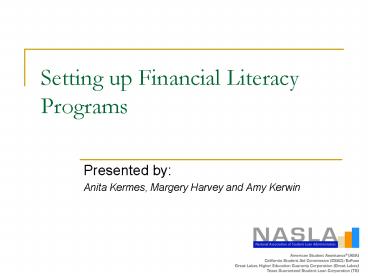Setting up Financial Literacy Programs - PowerPoint PPT Presentation
1 / 26
Title:
Setting up Financial Literacy Programs
Description:
Consumer rights include education debt management ... Online. edfund.org/BuildingFutures. Financial Literacy Resources ... Online format. Where to from here? ... – PowerPoint PPT presentation
Number of Views:58
Avg rating:3.0/5.0
Title: Setting up Financial Literacy Programs
1
Setting up Financial Literacy Programs
- Presented by
- Anita Kermes, Margery Harvey and Amy Kerwin
2
National Association of Student Loan
Administrators
- NASLA is organized to ensure
- consistent reliable delivery of student loan
services to Americas students, parents
postsecondary institutions. - In delivering student loan services, NASLA goals
include - Value-added benefits to schools and students
- Performance incentives and revenues structured to
support portfolio management, default prevention,
and other value-added services - Open systems and common data standards to foster
freedom of choice - Student advocacy
- Program Cost reduction
3
Voluntary Flexible Agreement and the evolving
role of the Guarantor
A Consumer Focus
- Federal student loan program should focus on
borrower as consumer - Consumer rights include education debt management
- America has chosen debt as the primary method for
funding higher education and therefore has a
responsibility to help students manage their debt - Education debt management Entitlement
4
Financial LiteracyWhat do we mean?Anita
Kermes, ManagerDefault Prevention Initiatives,
EDFUND
4
5
Building Futures Financial Literacy
6
Budgeting PowerPoint Presentations
7
Components and Where to Find
- Online
- edfund.org/BuildingFutures
8
Financial Literacy Resources offered by Guarantors
Margery Harvey Financial Literacy Program
Manager Texas Guaranty Student Loan Corporation
9
Resources for Professionals
- Guarantors offer many resources for professionals
to use in support of financial literacy,
including - Training courses for staff
- Community interaction and dialogue
- Identification of best practices
- Field support
- Courses for students
- Electronic
- In-person
- Materials, handouts, posters, etc
10
Resources for Consumers
- Guarantors also offer consumer focused resources
on many financial literacy concepts such as - Training courses on fundamentals of budgeting,
saving, making effective use of credit and debt,
paying for college, etc - Interactive websites and on-line tutorials
- Compilations of other public resources
11
Examples
- ASA
- Wellness Working is a Weblog that instigates a
conversation on topics ranging from practical
advice for borrowers, to insights for financial
aid professionals. www.amsa.com/blogs/wellnesswork
ing/index.cfm - EdFund
- Building Futures Financial Literacy is an
online resource to help explain valuable money
management concepts to your students on topics
such as Budgeting, Savings, and Credit.
www.edfund.org/schools
12
Examples
- Great Lakes
- Personal Financial Management is a collection of
tools and information to help students manage
their finances. www.mygreatlakes.org/borrower/ - TG
- PositiveBalance Community is a web site for
educators and financial aid professionals seeking
financial literacy information, featuring a
library and discussion blog. www.positivebalance.o
rg
13
Lessons Learned on Campus
- Efforts on campus vary in approach
- Best practices based on needs of school
- Many areas are involved in successful programs
(business office, faculty, student services,
registrar, etc) - Success relies on effective planning and
execution
14
Beyond the Workshop Bringing a Financial
Literacy Course to Campus
Amy Kerwin Chief Guaranty Officer, Great Lakes
15
The 20 Million Question
- Does financial education help students manage
their current economic needs and prepare for the
future?
16
Project Overview
- UW-Madison
- Developed a portable, flexible curriculum
- Piloted the course during spring of 2006
- Conducted evaluations pre-class, post-class, and
9 months post-class - Great Lakes provided funding
17
Learning Objectives
- Basic cash management
- Semester-based budgeting
- Credit, credit scores, and credit reports
- Financial aid
- Interest rates and compound interest
- Employee benefits
- Managing risk/choosing insurance
18
Course Evaluation Results
- Published July 2007
19
Spring 2006 Pilot Group
- Almost 300 students
- 179 completed pre- and post-surveys 77 completed
post-post survey - 37 took class purely as an elective
- Additional 24 would have taken class even if not
required
20
Class Demographics
- 95 19-23 years old
- 67 female
- 89 Caucasian
- 88 dependents
- 48 had fin. aid
21
Spending Diary Behavior
9 Months Post-Class
Pre-Class
Post-Class
Currently keeping a diary Planning to start a
diary
10.4
13.0
14.3
11.7
32.5
26.0
22
Budgeting Behavior
9 Months Post-Class
Pre-Class
Post-Class
Currently using a budget Planning to start a
budget
32.5
41.6
41.6
16.9
28.6
27.3
23
Renters Insurance Behavior
9 Months Post-Class
Pre-Class
Post-Class
Currently has insurance Planning to get insurance
22.1
26.0
33.8
24.7
28.6
28.6
24
Moving beyond Madison
- Curriculum is Portable
- 4-year public
- 2-year public
- Curriculum is Flexible
- Full semester, 3-credit course
- 7-week, 1-credit course
- Standard lecture format
- Online format
25
Where to from here?
- Focus on specific behaviors to prevent
delinquency and default - Entrance and exit counseling
- Debt management for repeat borrowers
- Know What You Owe updates
26
Questions????
- M.Harvey margery.harvey_at_tgslc.org
- A.Kermes akermes_at_edfund.org
- A.Kerwin AKerwin_at_glhec.org
- S.Saunders saunders_at_amsa.com
















![The Institute of Chartered Financial Analysts of India University - [ICFAI], Durtlong PowerPoint PPT Presentation](https://s3.amazonaws.com/images.powershow.com/9677438.th0.jpg?_=202110281211)














